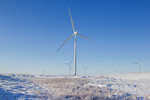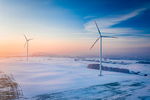Ilmatar commits to recycling the blades of all its wind turbines – wind farms nearly fully recyclable
With cooperation across industries and country borders, new solutions for recycling wind turbines are being constantly discovered. Ilmatar has pledged to recycle the blades from all its wind turbines with Stena Recycling’s recycling solution as the first Finnish energy company to do so. Blade recycling further underscores the importance of wind power as a sustainable form of energy.
Wind power plays a key role in reducing carbon emissions in Finland and across the world. Domestic wind power helps ensure fast and cost-efficient transition from fossil fuels to renewable energy sources. In addition to wind being a responsible energy source, the turbines themselves are expected to be sustainable. So what happens when a wind turbine or its components reach their end of life?
“Ilmatar wants to be a pioneer in recycling wind turbine blades in Finland. In addition to other carbon neutrality initiatives, circular economy solutions are key for us, and we have consequently pledged to recycle the blades from all our wind turbines. We welcome other wind turbine operators in Finland to join our efforts,” says Ilmatar’s CEO Juha Sarsama.
Wind turbines are not hazardous waste; they are close to fully recyclable
A wind turbine tower is primarily made of steel which can be efficiently recycled. However, the blades that rotate and generate energy contain materials that are challenging to recycle. They are primarily made from fibreglass and various other composite materials. Glass and composite materials are durable, malleable and lightweight, so they are highly suitable for any items that move continuously. In addition to wind turbines, they are commonly used in marine and aviation industry, for instance.
Fibreglass and composite are not classified as hazardous waste. They might rather be labelled as ‘demanding waste’ because they are challenging to recycle. In the past, these materials have primarily been disposed in landfills, which is the worst solution in terms of waste hierarchy.
With the new solutions, manufacturers can use composite materials to substitute virgin materials in the manufacturing of other products. As a result, even the demanding materials used in wind turbines climb up in waste hierarchy, benefitting the environment and supporting sustainable development.
Recycling solutions for composite materials reduce CO2 emissions
Stena Recycling began recycling wind turbines in Finland last autumn. Expanding the business came naturally as the company has been recycling wind turbines within the group itself for several years. The expertise and the solutions of Denmark’s Stena Recycling have been particularly applicable in Finland.
Currently, Stena Recycling recycles the fibreglass from wind turbines to cement production in Europe. The material is used to replace or complement cement raw materials. The company is also actively looking for Finnish and Nordic partners that could use fibreglass in their processes.
There has been some debate in the industry on whether using fibreglass in the carbon-emission-heavy cement industry is the best possible option for sustainable development. However, the European Composites Industry Association (EuCIA) estimates that if recycled composite materials make up 75% of cement’s raw materials, carbon emissions are reduced by 16%, justifying the use of the recycled materials in the industry.
Wind turbine recycling rate to exceed 90%
Once the fibreglass and other composite materials in the blades are recycled, the recycle rate of the whole wind turbine is over 90%. For the blades only, the current average recycle rate is 70–90%. The range is somewhat large because blade materials vary by manufacturer. While the fibreglass in the blades can be smartly recycled, the large amount of carbon fibre, among other materials, can make efficient recycling difficult.
“The more wind turbines we recycle, the more our knowledge on recycling increases and the more sophisticated our solutions become. I’m happy to see how wind turbine manufacturers and wind energy producers are involved in developing recycling together with us,” Stena Recycling Oy’s Business Manager Susanna Tarkka-Partanen says.
Cost can often be a deterrent because recycling can be more expensive than landfill disposal, depending on the materials used in the blades. The operator responsible for the disposal of wind turbines or their components ultimately decides whether they want to pay for recycling. Ilmatar proudly stands on the forefront of adapting pioneering recycling technology in Finland.
“When wind turbines are retired or their components are replaced, we need circular economy solutions for recycling them. Stena Recycling’s solution has already been tested and proven in practice,” Ilmatar Head of TCM Seppo Hakola says.
Recycling needs to be considered in planning
In addition to recycling the materials from retired wind turbines, it is important to explore how wind turbines can be developed for better reuse or recycling already at the planning stage. Only then it is possible to ensure that the principles of sustainable development are optimally fulfilled.
With Stena Recycling’s expertise on recycling and various materials, expanding cooperation to the planning of material use often comes organically. In addition to recycling, Stena is involved in the group’s research cooperation, exploring how wind turbine material selections affect recycling and how materials can be better recycled.
“I believe that in a few years we have developed even better recycling solutions, enabling more cost-efficient blade recycling. Cooperation across industries plays a major role in this,” Tarkka-Partanen says.
Extensive cooperation network ensures optimal recycling
In circular economy, cooperation is key. Expertise and understanding the entire value chain are a prerequisite for success – for the environment, for the climate and for the economy. Stena Recycling is an experienced recycler that, for instance, ensures that wind turbines can be dismantled, processed and recycled safely, in accordance with current legislation and in an environmentally responsible way.
The processing and recycling of materials always takes place at a Stena Recycling facility or in cooperation with select certified partners. The company is involved in all stages of the recycling process and, among other things, helps document that valuable raw materials are recovered, kept in the cycle and given new life in new products.
“By cooperating with us, you can ensure that materials and raw materials are recycled and converted into valuable resources in a sustainable way. We are an important part of the value chain for any company that wants to contribute to circular economy,” Tarkka-Partanen says.
“Responsible wind turbine blade recycling further underscores the importance of wind power as a sustainable form of energy”, Ilmatar CEO Juha Sarsama continues.
- Source:
- Ilmatar Energy
- Author:
- Press Office
- Link:
- ilmatar.fi/...
- Keywords:
- Ilmatar Energy, recycling, rotor blade, wind turbine, Stena Recycling, sustainable, CO2 emissions

























